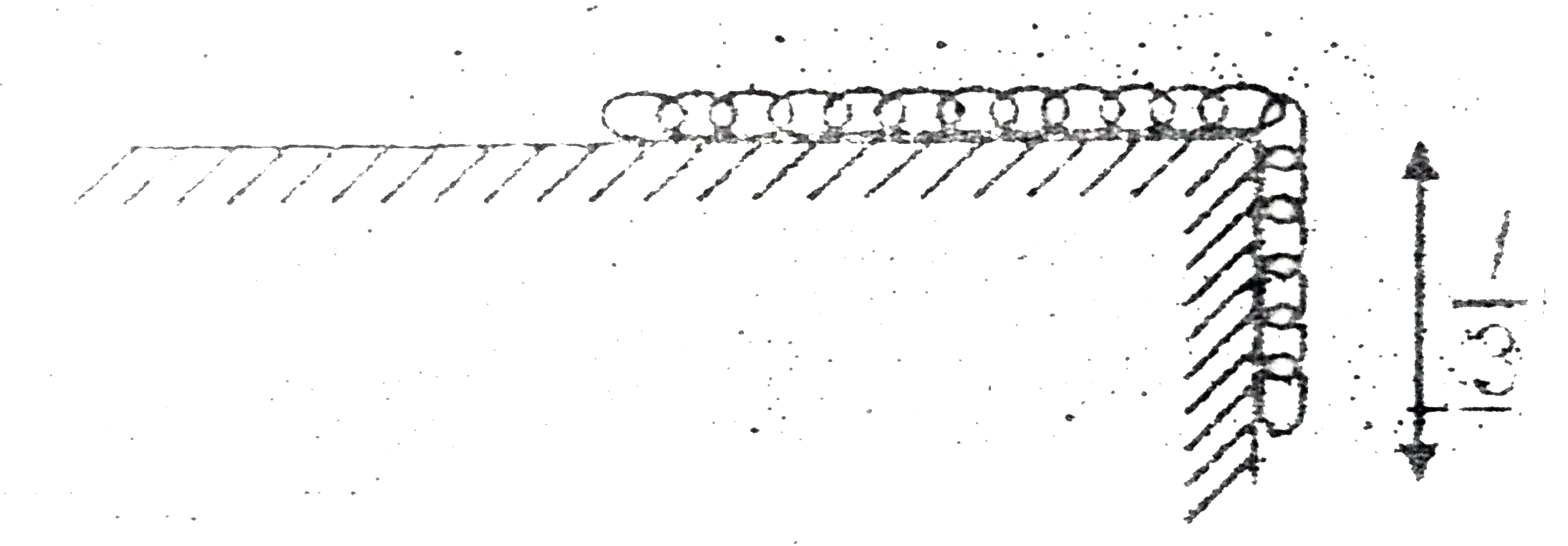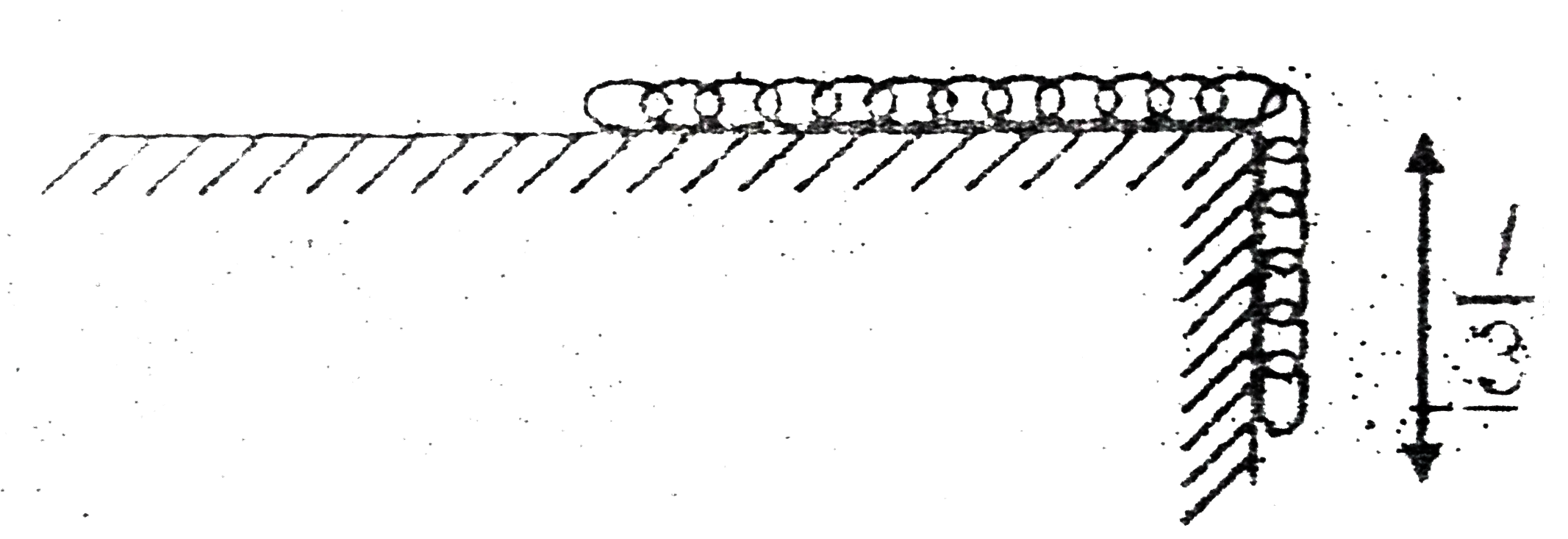A uniform flexible chain of mass m and length l hangs in equilibrium over a smooth horizontal pin of neglible diameter. One end of the chain is given a small verticle displacement so that the chain slips over the pin. The speed of chain when it leaves pin is
√gl2
√gl
√2gl
√3gl
The correct Answer is:A
To solve the problem of finding the speed of the chain when it leaves the pin, we will use the principle of conservation of energy. Here's a step-by-step breakdown of the solution:
Step 1: Understand the Initial and Final Positions of the Chain
- Initially, the center of mass of the chain is at a distance of l4 below the pin.
- After the small vertical displacement, the center of mass moves to a distance of l2 below the pin.
Step 2: Calculate the Change in Height of the Center of Mass
- The change in height of the center of mass (h) can be calculated as:
h=final position−initial position=l2−l4=l4
Step 3: Calculate the Change in Gravitational Potential Energy
- The decrease in gravitational potential energy (ΔPE) when the chain moves down by h is given by:
ΔPE=mgh=mg(l4)=mgl4
Step 4: Apply the Conservation of Energy Principle
- According to the conservation of energy, the decrease in potential energy is equal to the increase in kinetic energy (KE):
ΔPE=ΔKE
- The kinetic energy of the chain when it leaves the pin can be expressed as:
KE=12mv2
Step 5: Set Up the Equation
- Setting the decrease in potential energy equal to the increase in kinetic energy gives us:
mgl4=12mv2
Step 6: Simplify the Equation
- We can cancel m from both sides (assuming m≠0):
gl4=12v2
Step 7: Solve for v
- Rearranging the equation to solve for v2:
v2=gl2
- Taking the square root of both sides gives:
v=√gl2
Final Answer
- The speed of the chain when it leaves the pin is:
v=√gl2
- Initially, the center of mass of the chain is at a distance of l4 below the pin.
- After the small vertical displacement, the center of mass moves to a distance of l2 below the pin.
- The change in height of the center of mass (h) can be calculated as:
h=final position−initial position=l2−l4=l4
- The decrease in gravitational potential energy (ΔPE) when the chain moves down by h is given by:
ΔPE=mgh=mg(l4)=mgl4
- According to the conservation of energy, the decrease in potential energy is equal to the increase in kinetic energy (KE):
ΔPE=ΔKE
- The kinetic energy of the chain when it leaves the pin can be expressed as:
KE=12mv2
- Setting the decrease in potential energy equal to the increase in kinetic energy gives us:
mgl4=12mv2
- We can cancel m from both sides (assuming m≠0):
gl4=12v2
- Rearranging the equation to solve for v2:
v2=gl2
- Taking the square root of both sides gives:
v=√gl2
- The speed of the chain when it leaves the pin is:
v=√gl2
Topper's Solved these Questions
- BOOK - DC PANDEY ENGLISHCHAPTER - WORK, ENERGY AND POWEREXERCISE - MEDICAL ENTRANCE SPECIAL QUESTIONS16videos
WORK, ENERGY AND POWER
- BOOK - DC PANDEY ENGLISHCHAPTER - WORK, ENERGY AND POWEREXERCISE - MATCH THE COLUMNS7videos
WORK, ENERGY AND POWER
- BOOK - DC PANDEY ENGLISHCHAPTER - WORK, ENERGY AND POWEREXERCISE - CHECK POINT 6.310videos
WORK, ENERGY AND POWER
- BOOK - DC PANDEY ENGLISHCHAPTER - WORK, ENERGY & POWEREXERCISE - Level 2 Comprehension Based2videos
WORK, ENERGY & POWER
- BOOK - DC PANDEY ENGLISHCHAPTER - WORK, POWER AND ENERGYEXERCISE - E Integer Type Questions11videos
WORK, POWER AND ENERGY
Similar Questions
A uniform flexible chain of mass m and length 2l hangs in equilibrium over a smooth horizontal pin of negligible diameter. One end of the chain is given a small vertical displacement so that the chain slips over the pin. The speed of chain when it leaves the pin is
View SolutionA chain of mass m and length L is held at rest on smooth horizontal surface such that a part I of the chain is hanging vertically from the table. If the chain is let go, what is its speed as its end just leaves the horizontal surface?
View SolutionA uniform chain of mass m and length l is lying on a horizontal table with one-third of its length hanging over the edge of the table.

What is the speed of the chain, when it just loses contact with the table?View SolutionA uniform chain of mass m and length l is lying on a horizontal table with one-third of its length hanging over the edge of the table.

If the chain is limiting equlibrium, what is the coefficient of friction for the contact between table and chain?View SolutionA uniform chain of mass m & length L is kept on a smooth horizontal table such that Lnportion of the chaing hangs from the table. The work dione required to slowly bringsthe chain completely on the table is
View SolutionA uniform chain of mass m and length l overhangs a table with its two third part on the table. Fine the work to be done by a person to put the hanging part back on the table.
View SolutionA uniform chain of length L lies on a smooth horizontal table with its length perpendicular to the edge of the table and a small portion of the chain is hanging over the edge. The chain starts sliding due to the weight of the hanging part
View SolutionA uniform chain of mass 4 kg and length 2 m overhangs a smooth table with its one third part lying on the table Find the speed of chain as it completely slips of the table. (Take g=10ms2)
View SolutionHalf length of the chain of mass m and length / is overhanging. What is speed of chain when it just slips off the smooth table?
View SolutionA uniform chain of length l and mass m overhangs a smooth table with its two third part lying on the table. Find the kinetic energy of the chain as it completely slips off the table.
View Solution

